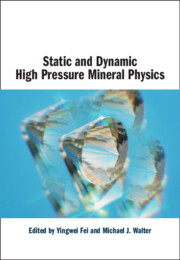Book contents
- Static and Dynamic High Pressure Mineral Physics
- Static and Dynamic High Pressure Mineral Physics
- Copyright page
- Contents
- Contributors
- 1 Introduction to Static and Dynamic High-Pressure Mineral Physics
- 2 Development of Static High-Pressure Techniques and the Study of the Earth’s Deep Interior in the Last 50 Years and Its Future
- 3 Applications of Synchrotron and FEL X-Rays in High-Pressure Research
- 4 Development of Large-Volume Diamond Anvil Cell for Neutron Diffraction: The Neutron Diamond Anvil Cell Project at ORNL
- 5 Light-Source Diffraction Studies of Planetary Materials under Dynamic Loading
- 6 New Analysis of Shock-Compression Data for Selected Silicates
- 7 Scaling Relations for Combined Static and Dynamic High-Pressure Experiments
- 8 Equations of State of Selected Solids for High-Pressure Research and Planetary Interior Density Models
- 9 Elasticity at High Pressure with Implication for the Earth’s Inner Core
- 10 Multigrain Crystallography at Megabar Pressures
- 11 Deformation and Plasticity of Materials under Extreme Conditions
- 12 Synthesis of High-Pressure Silicate Polymorphs Using Multi-Anvil Press
- 13 Investigation of Chemical Interaction and Melting Using Laser-Heated Diamond Anvil Cell
- 14 Molecular Compounds under Extreme Conditions
- 15 Superconductivity at High Pressure
- 16 Thermochemistry of High-Pressure Phases
- Index
9 - Elasticity at High Pressure with Implication for the Earth’s Inner Core
Published online by Cambridge University Press: 03 August 2023
- Static and Dynamic High Pressure Mineral Physics
- Static and Dynamic High Pressure Mineral Physics
- Copyright page
- Contents
- Contributors
- 1 Introduction to Static and Dynamic High-Pressure Mineral Physics
- 2 Development of Static High-Pressure Techniques and the Study of the Earth’s Deep Interior in the Last 50 Years and Its Future
- 3 Applications of Synchrotron and FEL X-Rays in High-Pressure Research
- 4 Development of Large-Volume Diamond Anvil Cell for Neutron Diffraction: The Neutron Diamond Anvil Cell Project at ORNL
- 5 Light-Source Diffraction Studies of Planetary Materials under Dynamic Loading
- 6 New Analysis of Shock-Compression Data for Selected Silicates
- 7 Scaling Relations for Combined Static and Dynamic High-Pressure Experiments
- 8 Equations of State of Selected Solids for High-Pressure Research and Planetary Interior Density Models
- 9 Elasticity at High Pressure with Implication for the Earth’s Inner Core
- 10 Multigrain Crystallography at Megabar Pressures
- 11 Deformation and Plasticity of Materials under Extreme Conditions
- 12 Synthesis of High-Pressure Silicate Polymorphs Using Multi-Anvil Press
- 13 Investigation of Chemical Interaction and Melting Using Laser-Heated Diamond Anvil Cell
- 14 Molecular Compounds under Extreme Conditions
- 15 Superconductivity at High Pressure
- 16 Thermochemistry of High-Pressure Phases
- Index
Summary
Elastic wave velocities and densities of iron and candidate iron alloys are important properties for understanding the seismological observations of Earth’s core. Several methods have been applied to measure the elastic wave velocities of iron and iron alloys at room temperature. Recently, measurements have been extended to simultaneous high-pressure and high-temperature conditions. Birch’s law, which is the linearity between density and compressional wave velocity (VP), is applicable to the experimental results of density and VP at high pressure and room temperature. The effect of temperature on Birch’s law is discussed, and it is not negligible at temperatures greater than 1,000–2,000 K. The VP and density of hcp Fe are extrapolated to pressure and temperature conditions of the inner core. VP of hcp Fe at 330–360 GPa is higher than the inner core seismic velocity, thus suggesting that iron should be alloyed with other elements so as to reduce not only its density, but also its velocity at inner core conditions. The VP of Fe–Si, Fe–H, and Fe–C alloys is slower than that of Fe at the pressure of the inner core. If the temperature effect on Birch’s law is taken into account, Si and H can be candidates for the major light elements in the inner core, while C, O, and S may not be included or exist as minor constituents.
Information
- Type
- Chapter
- Information
- Static and Dynamic High Pressure Mineral Physics , pp. 189 - 220Publisher: Cambridge University PressPrint publication year: 2022
